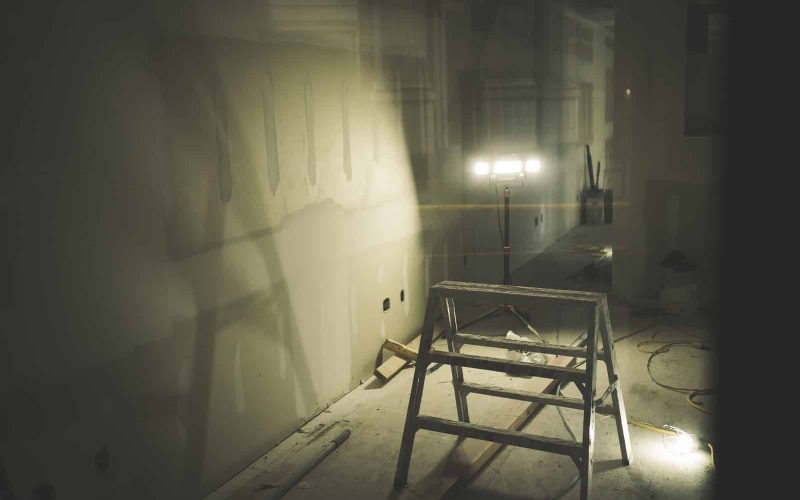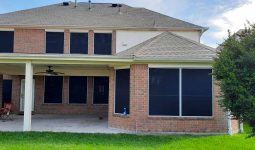Check out this list of best drywall alternatives, and learn more about your home’s interior wall covering options.
Plenty of better and more durable alternatives are available; drywall is not your only option.
Drywalls have a stylish appearance. The installation procedure, however, entails a lot of work and might not go smoothly for everyone. The material isn’t resistant to water damage or heavy use.
Drywall is not a good choice for cold areas because it is susceptible to mold and bacterial growth.
Drywall is not dense enough, so pressing a thumb against it causes hollow sounds.
Many people are forced to consider alternatives because of the numerous shortcomings of these building materials.
If you’re remodeling or building a new home, you want drywall with no flaws.
Here are some of the best drywall alternatives for your home decoration.
Wood Plank
Wood planks are a one-wall construction material that has endured the test. They have been employed for a long time and are still used today.
They are most cherished because of their elegant and rustic appearance. Additionally, they require less upkeep than conventional drywall.
Once mounted on your walls, wood planks won’t need to be altered or maintained. After installation, all you have to do is enjoy your home’s beauty. Due to their affordability, they make an excellent drywall substitute.
Overall, the wood planks are very lovely. These shouldn’t cause you too much trouble to install. Although they aren’t as simple to use as other options on this list, they won’t be too challenging to understand.
Wood planks also offer many options. You can select from various wood types to create the look you want.
Plastic Panels
If you are unfamiliar with these alternatives to drywall, the idea of using plastic panels might initially seem strange. In actuality, plastic panels are very nice for several reasons.
The installation of this tongue and groove wall panel is incredibly straightforward. You only need to lock it in place to be ready to go.
These plastic wall panels are frequently used to conceal damaged drywall. You won’t need much time to hang it, which is simple.
It might not be as economical to buy the tongue-and-groove paneling displayed here, but it is a fantastic choice if you need a drywall substitute.
Furthermore, It is simple to suggest plastic paneling as an alternative to drywall because it is very simple to install. You can directly cover up walls by screwing the majority of plastic paneling into place.
It’s convenient because you can place them now over the studs. Also, the plastic will be mold-resistant and easy to clean, which makes it ideal for rooms with a lot of moisture. This is one of the best types of drywall alternatives.
Plywood
Plywood is another excellent alternative to drywall for your walls, so the list of drywall substitutes is incomplete without it. Because it is so inexpensive, many people frequently choose plywood over drywall.
They’re not only inexpensive to buy, but they’re also a breeze to carry around. They are ideal for do-it-yourself projects because all you need to do is screw the wall into place, and you’re done.
When plywood has all the qualities you need, choosing the more expensive alternatives is unnecessary. You won’t ever regret installing plywood if you decorate these walls a little.
Veneer Plaster
Veneer plaster is the best option for a drywall substitute while maintaining the aesthetic. Thanks to their construction of thin drywall layers, veneer plaster features incredible finishing techniques. It is also easier to install than drywall because it already has its finishing.
Use drywall as the base to create a solid wall with veneer plaster. This procedure is very simple: You only need to apply veneer over drywall.
As it dries reasonably quickly, you should act as soon as possible because this will only take a short while. This is one of the best drywall alternatives.
Pegboard
Probably not; when considering drywall alternatives, the first thing that comes to mind is pegboard. However, it might be a worthwhile choice.
Pegboards are relatively simple and can increase storage space in a room. In garages, homeowners frequently use pegboard walls to hang their tools.
Furthermore, the pegboard needs to be secured to the studs, that’s all. You won’t have to go through any complicated finishing procedures, either.
All that is left to do is screw everything into place, and you are ready to use it. Of course, this option doesn’t offer many visual styles, but you probably won’t want to use pegboard inside your home anyhow.
The installation of this requires only that you screw it in. Place the pegboard correctly by locating the wall studs. Also, it shouldn’t be difficult for you to see where to place the screws. After you have secured the pegboard to the wall, you will finish your work.
Lath And Plaster
It can be an alternative to contemporary drywall if you want to construct your walls using an older technique. Before drywall was invented, lath and plaster were popular for building walls.
Although it won’t be the simplest solution, this approach will work. If you plan, you can construct a beautiful wall that will make it easy to install insulation.
Additionally, the overall aesthetic that lath and plaster walls can create is impressive. You should consider this if you want to construct a nice-looking wall in your house. However, it is not any simpler to use than drywall.
However, it is not any simpler to use than drywall. You should immediately disregard this choice if you’re looking for a drywall substitute to avoid the hassle.
Wahoo Walls
Since Wahoo Walls are primarily DIY projects, they are thought to be the most economical when it comes to installation.
You can install Wahoo walls without screws because the panels click together. Although not required, you can also glue them to the wall.
Since basements are where the walls are most frequently used, they are moisture-proof and won’t support mold growth.
Also, if your basement has leaky spots, you can use Wahoo to create the perfect drywall appearance. They’ll also guard against water damage to your house.
Textured Wall Panel
The most luxurious item on this list is textured wall paneling. Because of their aesthetics, they are primarily used in cocktail lounges and boutique hotels.
Homeowners started using it to add a lovely finishing touch to their homes because they wanted to take advantage of this beauty.
The price of textured walls is higher than that of other drywall substitutes. But because they are attractive, many people don’t mind spending money on them.
Some designs are available in 3D versions that are very simple to install—even on existing walls. This is one of the best drywall alternatives.
Basement Wall Finishing Systems
Systems for finishing basement walls are available in pre-designed, pre-cut panels. These panels can be used to complete and insulate your basement.
The walls are offered to basement owners as a solution. They are ideal for basements because they are water-resistant and can prevent mold growth.
However, the fact that basement wall finishing systems are so expensive is a drawback. You must be prepared to pay for professional services because the walls are inappropriate for a do-it-yourself project.
Brick And Masonry
Although stone and brick walls have been used for ages, they are still used today. Their warm aesthetics, lovely styles, and color make them a good substitute for drywall.
Brick and masonry are excellent choices for suburban or rural areas. This is primarily due to their toughness and longevity.
They also function well when combined with drywall. A common practice is using brick and masonry in one room and drywall to dry the adjacent rooms. The objective is to produce something distinctive and beautiful.
Furthermore, the price is one drawback. The cost of masonry and brick is higher than that of drywall. But because of how durable they are, the price is justified. They also need very little upkeep and are well-built homes. This is one of the best drywall alternatives.
Cement Board
Another excellent drywall substitute is cement board. Because cement boards are heavier than drywall, they require two people to lift them during installation. Cement boards are also water—and mold-resistant, making them great substitutes for drywall in high-humidity areas.
Lath With Woodchip-Clay
These walls are made of a combination of wood chips and clay slurry. The fiber provides strength, and the clay provides some insulation. Lath and woodchip clay are good wall options for cold areas and have a long lifespan due to all these factors. They also guarantee noise reduction. In place of conventional plaster and lath, they work well.
Fiberglass Reinforced Panels
The concept behind drywall is the same as that of fiberglass-reinforced panels. However, they are more resilient than drywall, which sets them apart.
They are constructed from durable, scratch-resistant materials. These panels are self-supporting. This implies that you won’t have to build this wall on top of another wall.
Furthermore, they will add an inch to your wall and make the space feel larger. Another benefit of fiberglass-reinforced panels is their resistance to mold and bacteria. They are affordable and straightforward to install solutions.
Fiberglass Mat Gypsum Panels
Fiberglass mat gypsum is the choice if you want something resembling painted drywall. Although they have a similar design to drywall, these panels are more moisture-resistant.
Their method of construction and the coated mat face give this substance additional strength. They are, without a doubt, a durable option for your house.
Exposed Concrete Block
Thanks to the exposed concrete block, your home has a contemporary look that is also aesthetically pleasing. They give it an unpolished, unfinished look that makes your wall appear incomplete but lovely. You can still paint the cinder blocks if you prefer a textured appearance.
However, leaving the wall alone still makes it ideal for your house. Play around with the decor by pairing it with glass and back furniture, for example.
Concrete Wall
Homes with concrete construction have a modern, industrial appearance. They provide the best decorative pieces and a design choice that characterizes modernity in any home.
They can choose to have an accent wall only or all four walls. Concrete walls are simple to maintain and clean. They don’t need special care, but a little polishing can help. This is one of the best drywall alternatives.
Brick
In addition to drywall, brick is a preferred alternative because of its aesthetic value. Both small accents and large walls can benefit from them. They arrive with a warm, uneven character that adds texture to your room.
Clay fired into bricks is used to disguise their porous and moisture-absorbing nature. Using a sealer to feel the pores and holes, you can keep them cozy and dry.
Due to their strength and durability, bricks are widely used. To make them beautiful and more straightforward to clean, add some paint.
Rammed Earth
Natural raw materials like compacted soil and gravel are used in rammed-earth construction to create walls, floors, and foundations.
This ancient technique has been brought into the modern age using precast panels. These panels are beautiful to eco-friendly builders because they are naturally durable, insulating, and long-lasting.
However, rammed earth panels can be hard to find and pricey to install. Nevertheless, they are one of the best drywall alternatives.
Sheet Wood
As a relatively simple material, sheet wood is ideal for do-it-yourself projects. It is a less expensive option than drywall.
With this material, you can give your finishing a sophisticated touch. You can proudly create a lovely country feel by combining sheet wood with some décor.
Cork Wall
The cork wall is perfect for those who enjoy experimenting with various designs. Thanks to the materials, you can add some of your favorite pictures and experiment with arbitrary designs.
So, take care not to hang any heavy objects from the board. They may be damaged by heavy materials. This is one of the best drywall alternatives.
Corrugated Metal
Have you entered some houses and seen waxy sheets on the sidewalk and the barn’s walls? These corrugated metals are ideal for use indoors.
They function well when used in a smaller accent wall. However, they might not be ideal for large or four-sided walls. Another inexpensive option is to use drywall, which is also inexpensive to install.
However, if you decide to do it yourself, you might run into trouble getting the right size cuts. You’ll need metal shears and a table saw with a specialized blade to cut them. It would be simpler to hire a pro to complete the task.
Vinyl Sliding
Given how standard vinyl is in homes, it would be a good drywall substitute. They come in incredibly simple-to-install plastic panels.
They are the ideal replacement for outdoor patios with some roofs over them. Also, they are simple to clean. They are ideal for shielding your wall from wind and precipitation.
Everlast Wall Panels
These plastic panels are cherished for their durability. They can withstand adverse circumstances and serve you for a very long time.
They are resistant to stains, mold, scratches, and moisture. Eliminating these ensures that your walls will last longer because they all cause damage to them.
Furthermore, they are ideal for kitchens, laundry rooms, and bathrooms because they can withstand moisture. Cleaning Everlast is simple. They can serve as effective drywall covers.
Barnwood
For those aiming for a rustic look, Barnwood is a fantastic option. Reclaimed wood provides the most genuine appearance, but it can be expensive and hard to find.
The most common material used to create panels is engineered wood, often in the form of highly rated Mountain Music Barnwood paneling from The Home Depot.
This type of Barnwood is produced in various styles and finishes and is typically inexpensive, simple to install, and washable. However, neither natural nor engineered wood is suggested for areas with high humidity. This is one of the best drywall alternatives.
Faux Bricks
Natural brick can add texture and visual interest to a space and is an excellent choice for rustic and industrial settings.
Conversely, faux brick is a lightweight, simple-to-install substitute for masonry if you want an appearance without all the time-consuming work.
Panels are affordable and come in various designs and hues, like this traditional red brick option from The Home Depot.
Few types of faux brick are fire-rated, though most are water-resistant.








